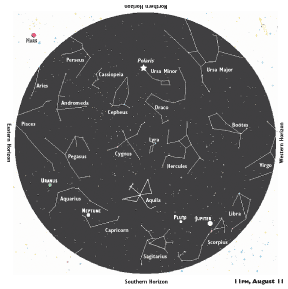A Rain of Fiery Tears
New moon coincides with this year’s Perseid meteor shower
Every day and every night, Earth’s orbit crosses paths with errant bits of cosmic dust and debris, which ignite upon contact with our atmosphere. The larger these meteors, the brighter the blaze and the farther they streak. Most times, seeing a single meteor streaking across the sky is a matter of luck.
However, the regular comings and goings of comets and an asteroid provide us with more predictable meteors. Each year in mid-August, Earth passes through the trail of comet Swift-Tuttle, which orbits our sun every 130 years or so. The resulting meteors, the Perseids, are one of the best showings. Better yet, they peak this year during new moon.
You can see Perseid meteors in any part of the sky, but they all appear to emanate from the constellation Perseus, which rises in the northeast around 11pm. Late Sunday and early Monday offers the greatest concentration; as many as 80 meteors an hour may streak across the sky.
Even now and in the week following the peak, the Perseids deliver smaller counts, ranging from a dozen an hour to 30 or 40 on the 11th/12th and the 13th/14th.
The Perseids are also known as the Tears of St. Lawrence, named after the early Christian martyr Laurentius. In the midst of being tortured upon an outdoor stove, Laurentius cried out to his Roman tormentors, “I am already roasted on one side, and, if thou wouldst have me well cooked, it is time to turn me on the other.” The celebration of the martyr Laurentius’s death and the feast of St. Lawrence on August 10 coincides with the annual peak of fiery tears criss-crossing the skies between August 8 and 14.
Tidelog®
Illustration: © Copyright 1925 M.C. Escher/Cordon Art-Baarn-Holland; Graphics: © Copyright 2007 Pacific Publishers. Reprinted by permission from the Tidelog graphic almanac. Bound copies of the annual Tidelog for Chesapeake Bay are $14.95 ppd. from Pacific Publishers, Box 480, Bolinas, CA 94924. Phone 415-868-2909. Weather affects tides. This information is believed to be reliable but no guarantee of accuracy is made by Bay Weekly or Pacific Publishers. The actual layout of Tidelog differs from that used in Bay Weekly. Tidelog graphics are repositioned to reflect Bay Weekly’s distribution cycle.Tides are based on National Oceanic and Atmospheric Administration and are positioned to coincide with high and low tides of Tidelog.
